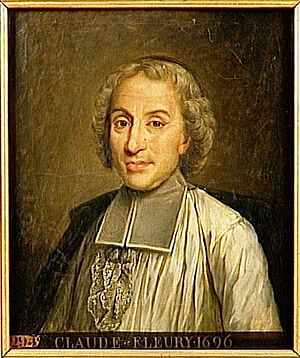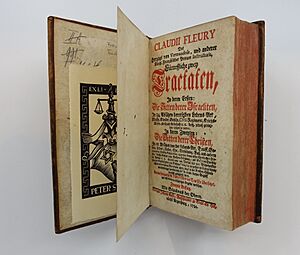Claude Fleury facts for kids
Claude Fleury (born December 6, 1640, in Paris; died July 14, 1723, in Paris) was an important French priest, lawyer, and historian. He is best known for writing a very long history of the Christian Church.
Contents
Early Life and Royal Service
Claude Fleury first studied law at the famous College de Clermont in Paris. In 1658, he became a lawyer in the Paris court system. He worked as a lawyer for nine years.
A well-known preacher named Bishop Jacques-Bénigne Bossuet noticed Fleury. Bossuet encouraged him to study theology and become a priest. This led Fleury to gain the attention of King Louis XIV.
In 1672, King Louis XIV appointed Fleury as a tutor for young princes. He taught the princes of Conti and later the count of Vermandois. For his service, the king gave him the Cistercian abbey of Loc-Dieu. An abbey was a type of monastery.
Growing Influence and Recognition
Fleury's teaching duties for the royal family expanded in 1689. He became a sub-preceptor for the dukes of Burgundy, Anjou, and Berry. He worked closely with François Fénelon, who was their main tutor.
In 1696, Fleury was chosen to join the Académie française. This is a very important French institution that protects the French language. After the princes finished their education, the king gave Fleury a new, more profitable position. This was the priory of Argenteuil in 1706.
Writing the Church's History
Around this time, Fleury began his most famous work, the Histoire ecclésiastique. This means "Ecclesiastical History" or "Church History." He had been gathering information for this huge project for 30 years.
Fleury wanted to write a history of the church for everyone. However, his work focused a lot on religious ideas and rules. It also covered the power struggles between the church and rulers. Because of this, it was more popular with students and scholars than with general readers.
Despite this, the book was very successful. The first edition came out in Paris in 1691. It had 20 volumes! Many other editions were printed later. Fleury's history covered events up to the year 1414. Other writers, Jean Claude Fabre and Goujet, continued his work up to 1595. The entire work was translated into Latin, German, and Italian.
Later Life and Other Works
In 1716, Fleury became the confessor to the young King Louis XV. A confessor is a priest who hears confessions and gives spiritual advice. He was chosen because he was seen as a balanced and fair Catholic. People admired his great knowledge, humble life, and honest behavior.
Besides his famous Histoire ecclésiastique, Claude Fleury wrote many other books. Some of his notable works include:
- Histoire du droit français (1674) – A history of French law.
- Mœurs des Israelites (1681) – About the customs of the Israelites.
- Mœurs des Chrétiens (1682) – About the customs of Christians.
- Catechisme Historique (1683) – A historical catechism, which is a summary of religious teachings.
- Traité du choix et de la méthode des études (1686) – A guide on how to choose and approach studies.
- Les Devoirs des maîtres et des domestiques (1688) – About the duties of masters and servants.
Some of his smaller works were published together in 1807. However, the Roman Congregation of the Index, a church group, banned two of his books: Catéchisme historique and Institution du droit ecclésiastique.



